



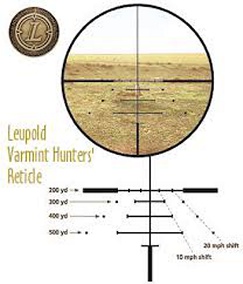
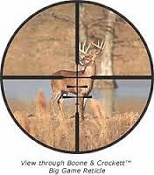

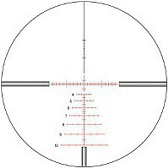
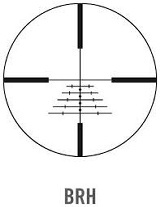









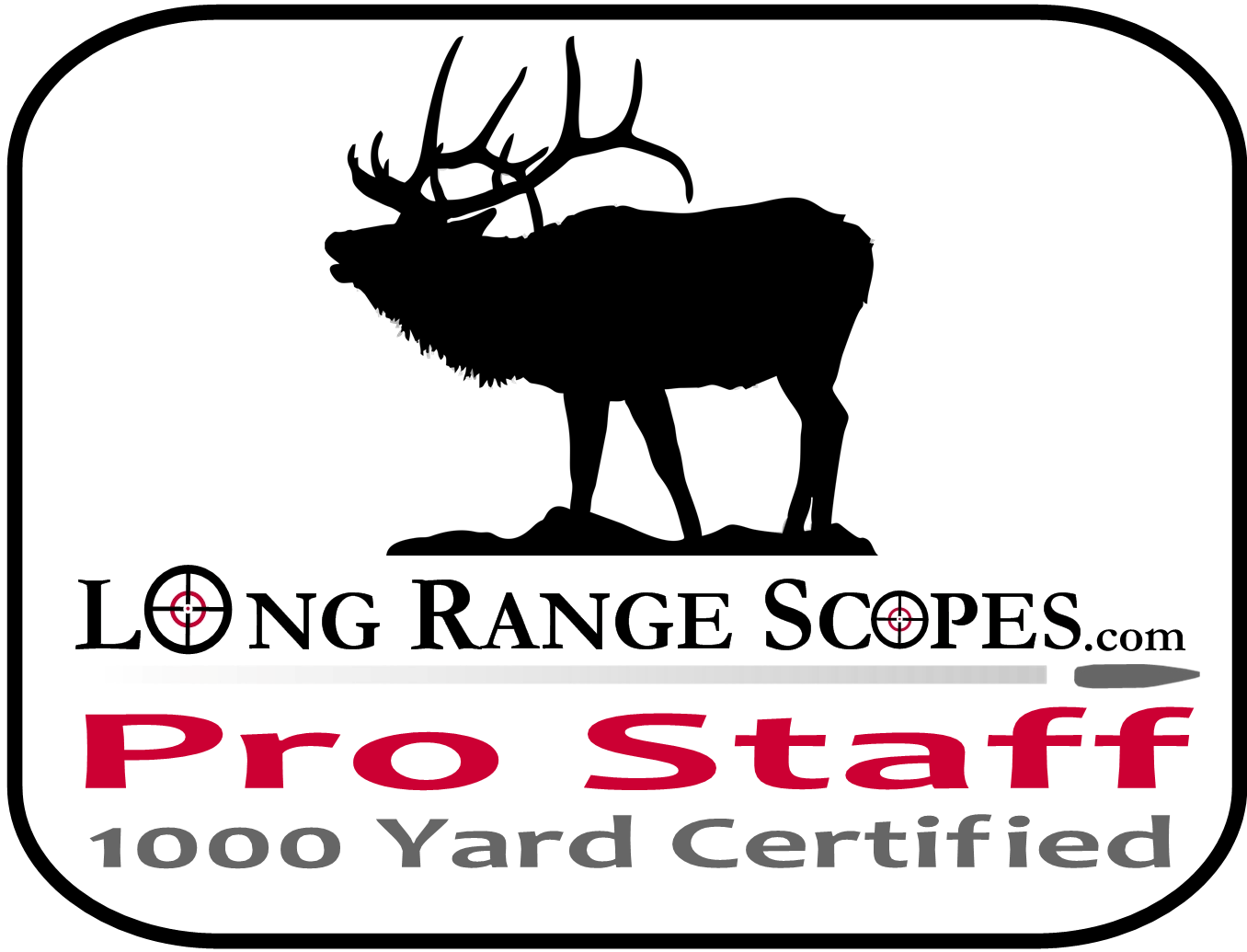
The Best Long Range Scopes & How To Choose One:
RANGE IT ! DIAL IT ! SHOOT IT !
The introduction of affordable ballistic laser range finders combined with new ballistic reticles and 1000 yard turret options offered by the best long range scope manufacturers is changing how long range scopes are chosen.
Long Range Shots are now as easy as taking a range finder reading - automatically adjusted for temperature, altitude, weather, and inclination by the rangefinder - and then placing the scopes corresponding distance reticle on the target and firing. Alternately you can dial the distance indicated on the scope's turret and place the main cross hairs on the target and fire. No mil-dots or minutes of angle to compute or clicks to add or subtract for different variables. All of these recommended scopes include both ballistic reticle and turret aiming options so you can decide after actual use which you prefer and when. Beyond 500 yards you may find using the turrets inspires more confidence in your shot placement depending upon type of reticle chosen. The ballistic reticles and the turrets are selected and adjusted to match your rifle and ammunitions ballistics. This is not to say that practice isn't required to get both you and your equipment dialed in.
LONG RANGE SCOPE BALLISTIC RETICLES
The introduction of affordable ballistic laser range finders combined with new ballistic reticles and 1000 yard turret options offered by the best long range scope manufacturers is changing how long range scopes are chosen.
Long Range Shots are now as easy as taking a range finder reading - automatically adjusted for temperature, altitude, weather, and inclination by the rangefinder - and then placing the scopes corresponding distance reticle on the target and firing. Alternately you can dial the distance indicated on the scope's turret and place the main cross hairs on the target and fire. No mil-dots or minutes of angle to compute or clicks to add or subtract for different variables. All of these recommended scopes include both ballistic reticle and turret aiming options so you can decide after actual use which you prefer and when. Beyond 500 yards you may find using the turrets inspires more confidence in your shot placement depending upon type of reticle chosen. The ballistic reticles and the turrets are selected and adjusted to match your rifle and ammunitions ballistics. This is not to say that practice isn't required to get both you and your equipment dialed in.
LONG RANGE SCOPE BALLISTIC RETICLES
Ballistic Reticle Limitations: The most important reason to have a scope offering ballistic
turrets in addition to ballistic reticles is that while the main crosshairs are accurate at all zoom
settings the extra ballistic markings are ONLY ACCURATE AT A SINGLE ZOOM SETTING. This
scope-dependent zoom setting is typically at or near the maximum scope power which is what
most shooters would utilize for long range shooting anyway. So if you want to shoot at any zoom
power other than that specified you must set the ballistic turret to the ranged distance and put
the main crosshairs on the target. It's common to just leave the turret set to 200 yards and then
use the main cross hairs up to longer ranges and then use the turrets to adjust for long shots if
time allows or the ballistic reticle if the shot is hurried. Most users eventually use one or the
other method exclusively after getting used to either.
LONG RANGE SCOPE BALLISTIC TURRETS
The ballistic turrets are similar among all these scopes in that they are available marked with distances in yards to match your rifle's and ammunition's ballistics holdover requirements. Some scopes like the Nightforce have what is called a zero-stop option so they can quickly be reset to zero in addition to being a high-speed or single-turn turret meaning that the turret can go from 100-1000 yards in a single turn. Custom turrets can be ordered from companies like kentonindustries.com (all) , Gunwerks (Nightforce) , Outdoorsman ballistic turret (Swarovski). You provide them with your ballistics information and they engrave a blank turret to match your bullets trajectory at the conditions you provide them. A turret is only accurate for the type of ammunition it was made for - speed, shape, and weight so you would need additional turrets for different loads of ammunition to maintain accuracy, or adjust your zero on the turrets or rangefinder. A complaint against ballistic turrets and reticles used to be that they needed to be changed for different elevations, and temperatures but the new ballistic rangefinders automatically now account for this by outputting "corrected ballistic range".
LONG RANGE SCOPE BALLISTIC TURRETS
The ballistic turrets are similar among all these scopes in that they are available marked with distances in yards to match your rifle's and ammunition's ballistics holdover requirements. Some scopes like the Nightforce have what is called a zero-stop option so they can quickly be reset to zero in addition to being a high-speed or single-turn turret meaning that the turret can go from 100-1000 yards in a single turn. Custom turrets can be ordered from companies like kentonindustries.com (all) , Gunwerks (Nightforce) , Outdoorsman ballistic turret (Swarovski). You provide them with your ballistics information and they engrave a blank turret to match your bullets trajectory at the conditions you provide them. A turret is only accurate for the type of ammunition it was made for - speed, shape, and weight so you would need additional turrets for different loads of ammunition to maintain accuracy, or adjust your zero on the turrets or rangefinder. A complaint against ballistic turrets and reticles used to be that they needed to be changed for different elevations, and temperatures but the new ballistic rangefinders automatically now account for this by outputting "corrected ballistic range".
Swarovski
Nightforce
Velocity 1000
Velocity 1000
Schmidt & Bender
LR Hunter
LR Hunter
Leupold
Boone & Crocket
Boone & Crocket
Nightforce
MOA-R
MOA-R
Continue for more on Choosing a Long Range Scope.
What are MOA and MIL-RAD or MIL-DOT ?
Best Scope Power (Zoom) for a Long Range Scope?
What size scope objective ? 50mm - 52mm - 56mm?
What tube size, 1" or 30mm ?
What Rangefinder for Long Range Shooting ?
Calculating Distance without a Rangefinder - MOA
Rangefinding Scopes - Holland Advanced Reticle System & Shepherd Scopes
Long Range Scope Packages - 1000 Yards out of the box.
<page 2 >
What are MOA and MIL-RAD or MIL-DOT ?
Best Scope Power (Zoom) for a Long Range Scope?
What size scope objective ? 50mm - 52mm - 56mm?
What tube size, 1" or 30mm ?
What Rangefinder for Long Range Shooting ?
Calculating Distance without a Rangefinder - MOA
Rangefinding Scopes - Holland Advanced Reticle System & Shepherd Scopes
Long Range Scope Packages - 1000 Yards out of the box.
<page 2 >
Home of the 1000 Yard Scopes: Swarovski, Leupold, Nightforce, Schmidt & Bender & more





